Introduction
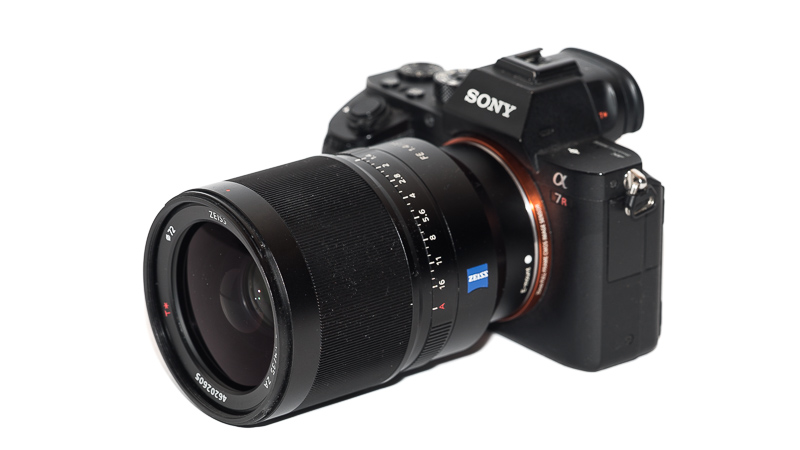
The Sony FE 35mm 1.4 ZA was the first f/1.4 prime for the Sony FE system. But can it keep up with the latest GM lenses available today? Find out in this review!
Sample Images
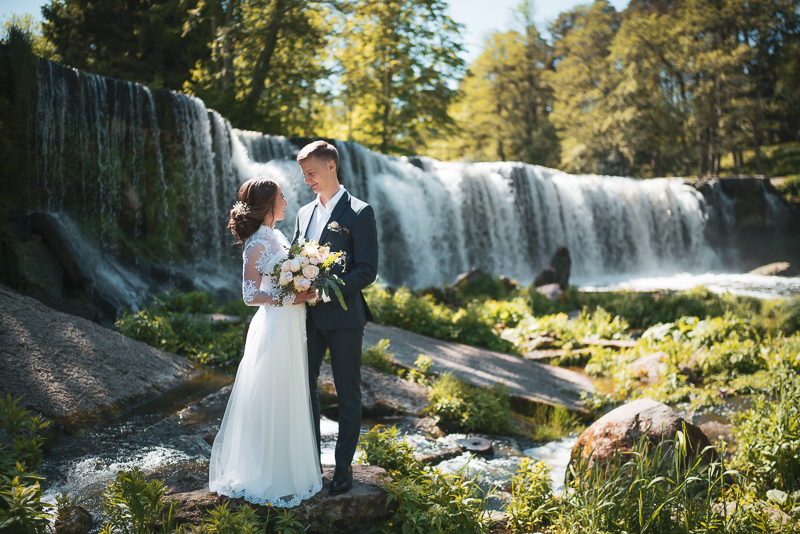
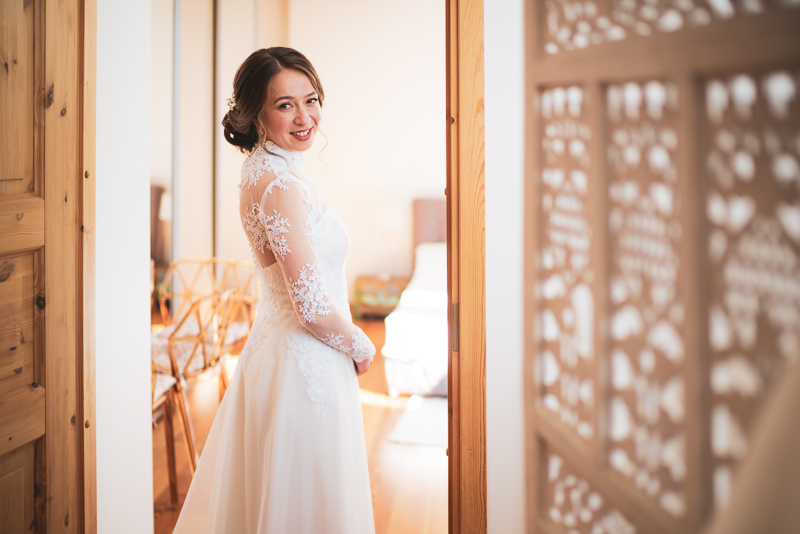
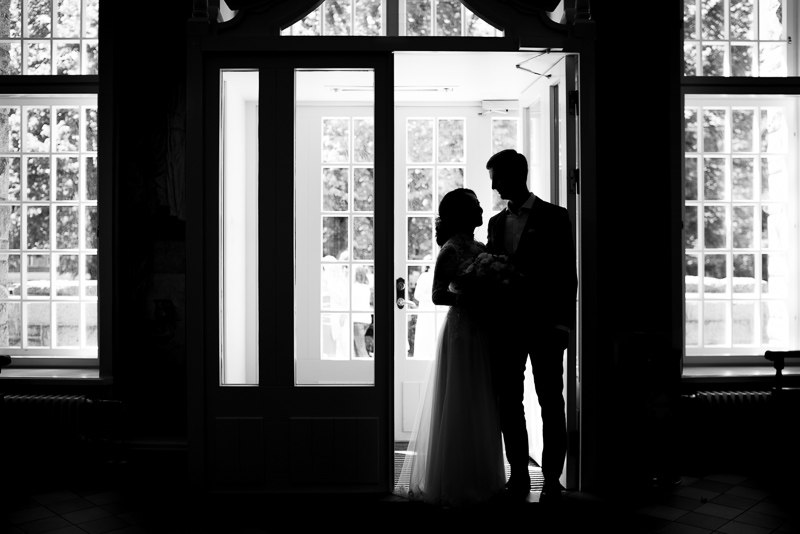
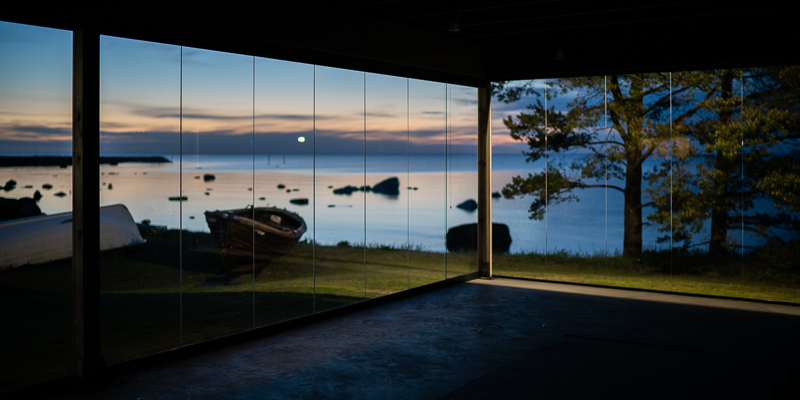
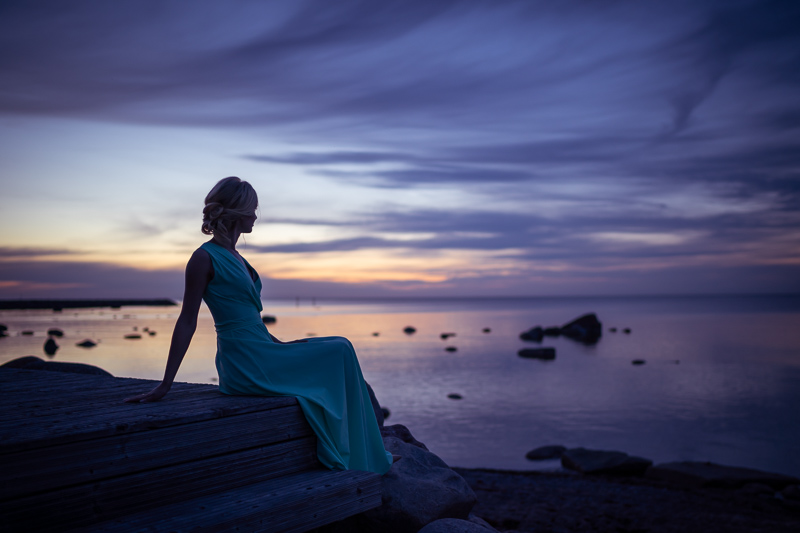
Most of the sample images in this review can be found in full resolution here.
Contents
Specifications / Version History
Introduced in the beginning of 2015 the Sony FE 35mm 1.4 ZA was the first “high end” f/1.4 prime for the Sony Full Frame mirrorless. The lens has the following specifications:
-
- Diameter: 79 mm
- Field of view: 63° (diagonally)
- Length: 113 mm
- Weight: 630g (without hood and caps)
- Filter Diameter: 72 mm
- Number of Aperture Blades: 9 (rounded)
- Elements/Groups: 12/8
- Close Focusing Distance: 0.30 m
- Maximum Magnification: 1:5.6
- Mount: Sony-E
You may also have a look at the official page.
You can usually find the Sony FE 35mm 1.4 ZA on amazon.com/amazon.de, B&H or ebay.com/ebay.de for about $1499/1499€ new or used for a few 100 bucks less (affiliate links)
Disclosure
This lens is known for its very high sample variation. Already in March 2018 one reader sent me one, but I only used it to take the product shots and then had to return it due to being heavily decentered.
This second sample is the best centered one I have seen so far, so I can finally review this lens.
Operation
Handling
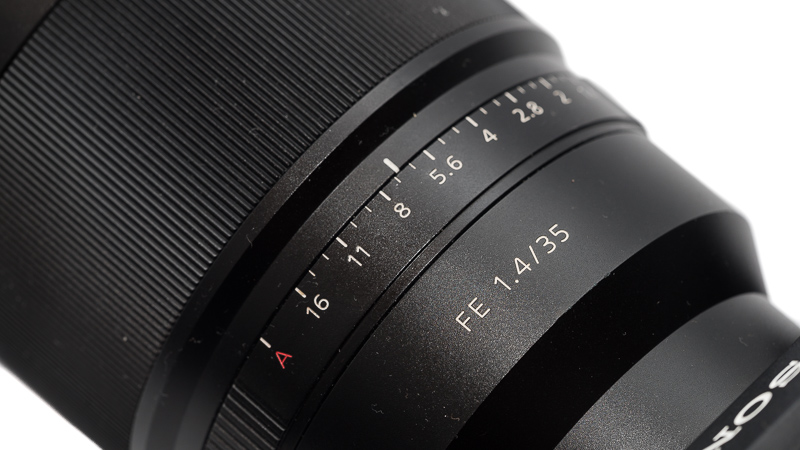
To my knowledge this was the first E-mount lens to feature a physical aperture ring (1/3rd of a stop click stops) which is surely a nice touch. The clicks are not as distinct as on the newer GM lenses but that surely isn’t a problem. The ring can also be declicked for video usage.
The focus ring is unfortunately of the non-linear type, so depending on how fast you turn it the AF motor inside the lens will move the elements only a little or a lot.
I really don’t like this and greatly prefer the linear manual focus of the GM lenses. But if you don’t intend to ever manually focus this lens that surely won’t bother you.
Unfortunately there are no other buttons or switches on the lens. No AF/MF switch, no focus hold button (sometimes referred to as lens button). This is also a real let down compared to the GM lenses.
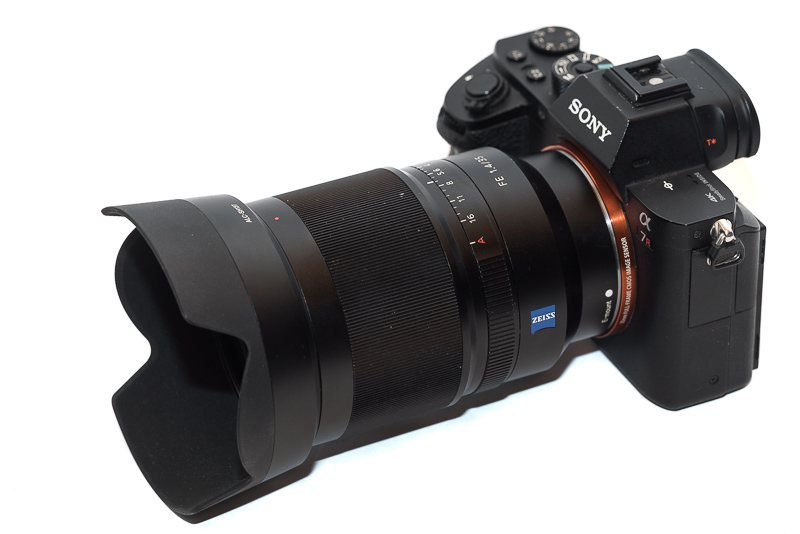
A bayonet type lens hood with rubberized fron part is also part of the package. For transport it can be mounted reversed.
In this category the Sony FE 35mm 1.4 ZA surely falls short compared to the newer GM lenses.
Build Quality
The ZA casing seems to be mostly made of metal, but these type of casings haven’t really proven to be scratch resistant.
But apparently it is well sealed and rather durable compared to even earlier FE lenses.
Autofocus
I haved only used the lens for slow moving adults and encountered no problems with the autofocus. If you primarily want to take pictures of running animals or small children you may come to a different conclusion.
Eye-AF also works generally well, but you have to be close to your subject for the camera to actually recognize an eye in the frame. So at the distances I was mostly using this lens the cameras usually resorted back to face-detect mode.
Vignetting
light falloff
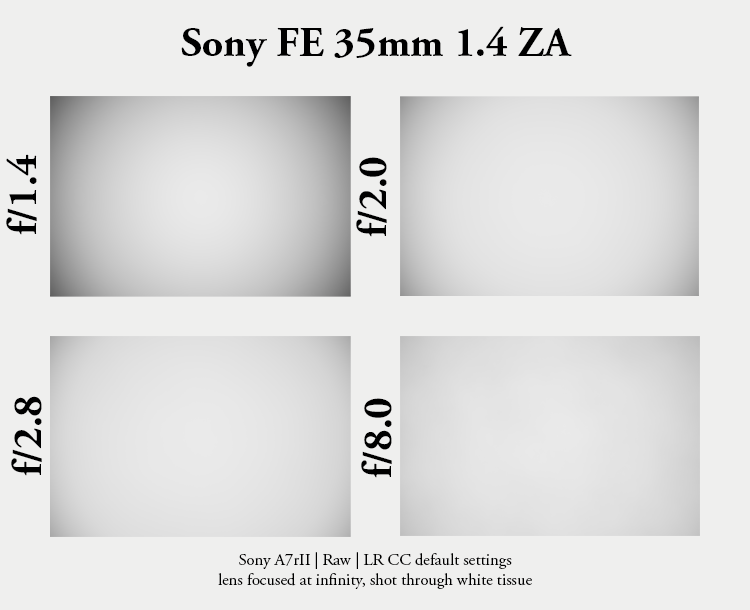
Wide open there is strong light falloff of roughly 2.8 EV, stopped down to f/2.0 this improves to 2.0 EV, stopped down to f/2.8 it is 1.6 EV and further improves to 1.3 EV at f/8.0. These values are comparable to the competition in this class. You can either correct this in Lightroom or directly in camera.
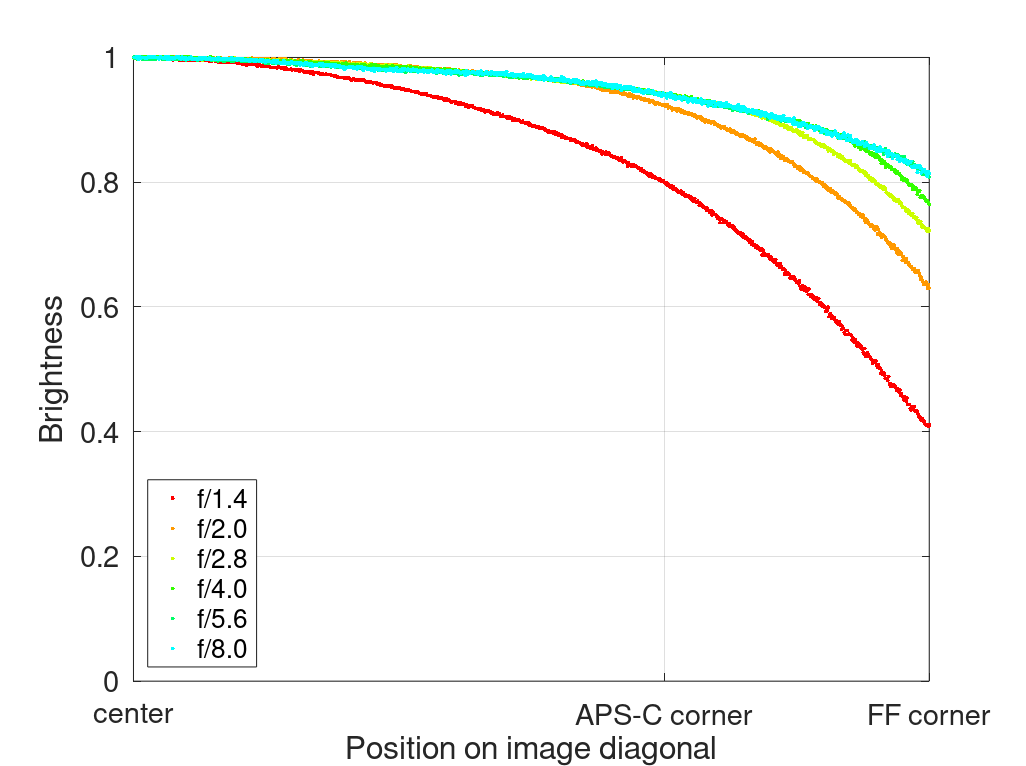
It is recommended to have a look at this article first to get an idea how this brightness graph works.
color cast

The lens also shows a slight green color cast in the corners and towards the borders, similar to the Voigtlander VM 28mm 2.0 Ultron or the 7artisans 28mm 1.4 FE+. This is not visible in every shot, but can be noticeable e.g. when shooting with an overcast sky in the background.
This can be corrected e.g. by cornerfix or using gradients in Lightroom (the latter being my preferred option).
optical vignetting
Very fast yet compact lenses usually show a significant amount of optical vignetting. Without going too much into technical details mechanical vignetting leads to the truncation of light circles towards the borders of the frame.
In the center of the frame almost every lens will render a perfect circle, but only lenses with very low optical vignetting will keep this shape in the corners.
So in the following comparison we move from the center (left) to the extreme corner (right) and see how the shape of the light circle changes.
I did not shoot the lenses side by side, but the results are still giving us an idea of what to expect here.
Due to its huge size I expected the 35mm 1.4 ZA to perform a bit better to be honest, but the wide open optical vignetting is very comparable to that of the Voigtlander VM 35mm 1.7. Stopped down to f/2.0 the Sony pulls a bit ahead in the corners though.
And also the small 7artisans 28mm 1.4 FE+ fares no worse in this category.
You can also see the obvious onion ring structures in the 35mm 1.4 ZA crops, more on that in the bokeh section.
Sharpness
Sample variation / Variance
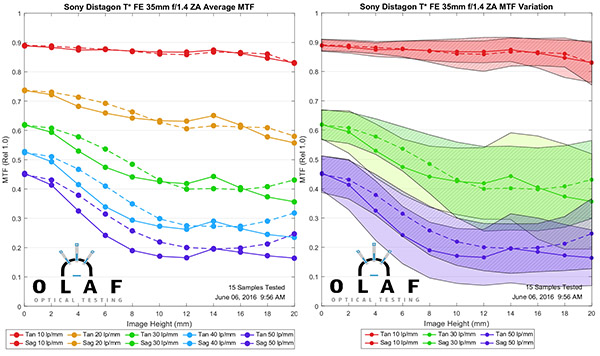
This lens is known to have rather high sample variation and while it usually is hard to get decent numbers on this, the guys from Lensrentals actually measured a host of copies and put together these graphs.
The wider the areas in the right graph the worse the sample variation. And those bars are really wide for the Sony FE 35mm 1.4 ZA.
This means it is possible you get a great copy. It also means it is more likely you get a not so great copy and really likely you get a copy with very uneven corner performance.
This sample also doesn’t show 4 perfectly even corners at f/1.4, but it is still the best sample I have seen so far.
So I can’t say if this performance is what you can or should expect, keep that in mind when having a look at the following sections.
infinity
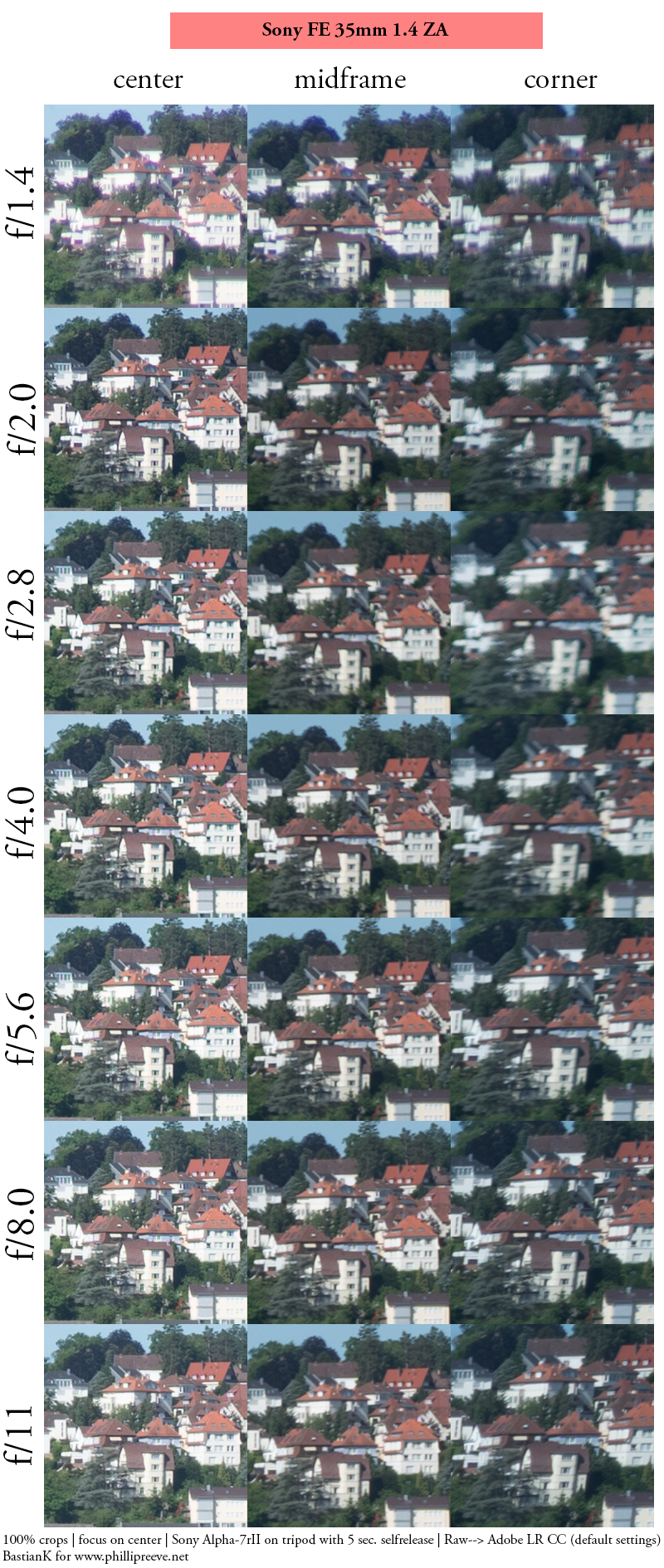
Wide open you can see lots of longitudinal CA at infinity and also a bit of glow. Luckily most of this goes away on stopping down to f/2.0.
While the center shows almost no detectable focus shift midframe and corners are a whole different story. Here the plane of optimal focus shifts quite a bit on stopping down.
To avoid issues due to this best use f/8.0 for landscape/architecture applications.
I am sure many of you are tempted to tell me how their sample is better. I am more sure that many of you never checked their lens as I did here though (as it is a rather boring task). And I am even more sure for many of you this doesn’t matter as this is not the application people are usually buying this lens for.
portrait distance
For portraiture it isn’t so important how flat the field is, it is more interesting to see what the sharpness is like when focused at different parts of the frame to take field curvature out of the equasion.
This is what I did here, I refocused for every shot to get the best possible result at different locations in the frame (center, inner midframe, outer midframe and corner).
Focus distance was roughly 1,0 m and the circle of the dollar bill is more or less the size of a human eye.
In my 35mm comparison I found out that the Voigtlander VM 35mm 1.7 is a really strong performer in this regard (it also is the only 35mm I currently own) so I decided to use it for a comparison.
Sony FE 35mm 1.4 ZA <—> Voigtlander VM 35mm 1.7 + 5m PCX
100%, A7rII
No matter what part of the frame you are looking at, the VM 35mm 1.7 always looks better. Both lenses are very close in the center though.
It shall be noted that the Voigtlander lens is half a stop slower, so this is obviously not an entirely fair comparison.
close (0.30 m, 1:5.6)
100% crops from center, A7rII
Unlike many other lenses the contrast is quite high at the minimum focus distance, but the amount of details rendered is not. Stopping down to f/2.0 mostly solves this, from f/2.8 onwards I would call the close up performance excellent.
But for most applications it is more than sufficient at f/1.4:
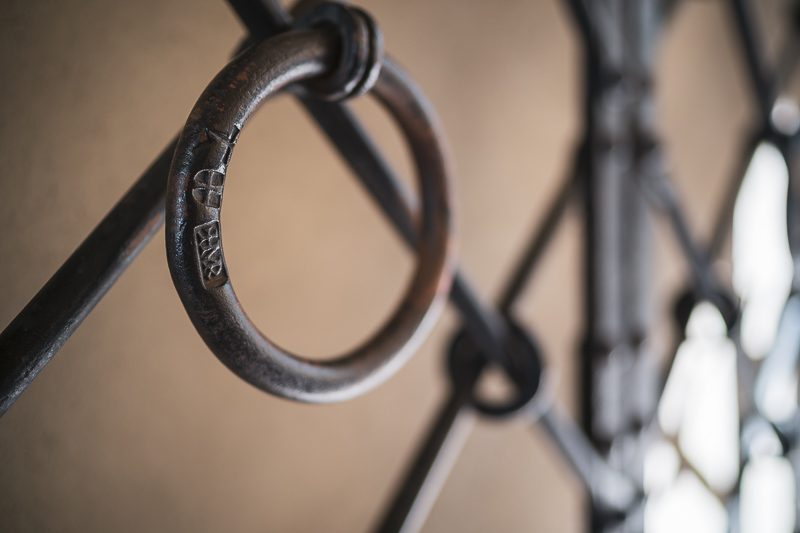
Flare resistance
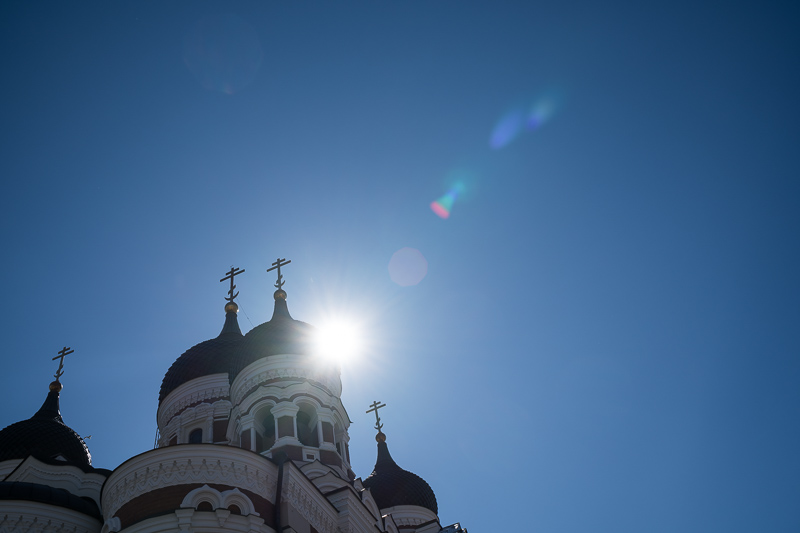
When shooting directly into the sun contrast stays on a rather high level. There are a few – mostly small – ghosts visible across the frame.
When you place the sun close to the corner you can catch slightly bigger but also less saturated ghosts. Also, when the sun is outside the frame, – and even when using the hood – you can sometimes catch veiling flare running across the frame .
There are a few 35mm lenses that fare better (like the Voigtlander VM 35mm 1.7 Ultron), but this is still not a bad performance.
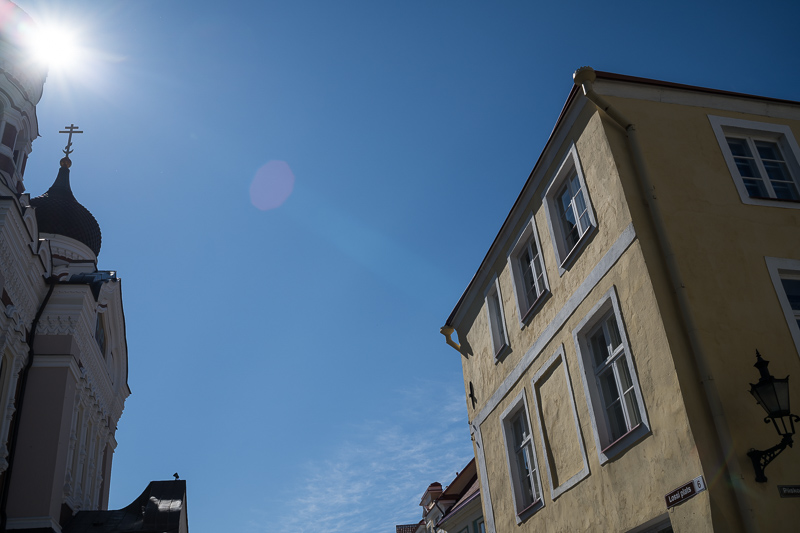
Coma
At f/1.4 the coma performance isn’t exactly great and the sharpness is also lacking a bit. Stopping down to f/2.0 improves the performance significantly and by f/2.8 it starts to look really good.
Also note that I focused on the corners for these shots, if you focus on the center the corners will look slightly worse.
I would expect the Sigma 35mm 1.4 Art to perform better in this category.
100% crops from extreme corner, focused on corner, A7rII
Distortion
The lens has rather strong and wavy barrel distortion. There are of course lens profiles to correct this available, either in camera or in post.
Bokeh
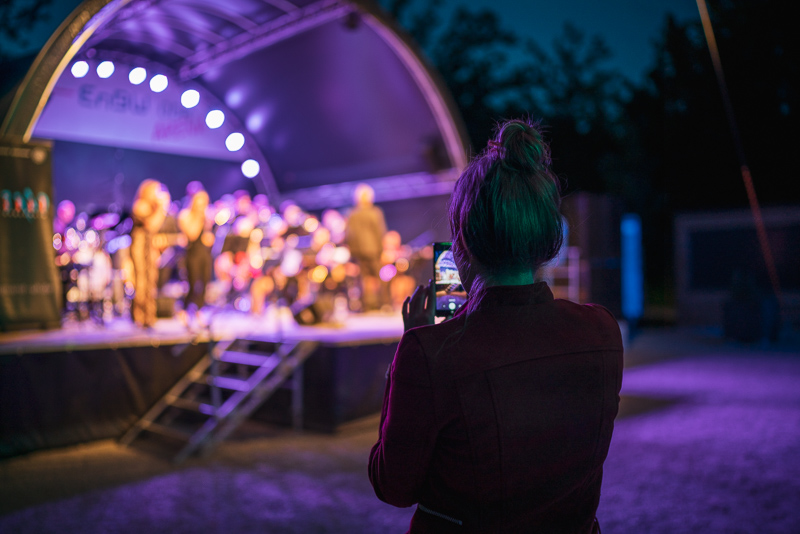
The bokeh rendering is surely one of the main reasons to get a fast 35mm lens. It would surely be for me. The Sony FE 35mm 1.4 ZA is reknown to offer a pleasing out of focus rendering, but let us have a closer look how it performs at different distances.
In close focus scenarios the bokeh is pretty nice, smooth and with very noticeable subject separation due to the high contrast rendering:

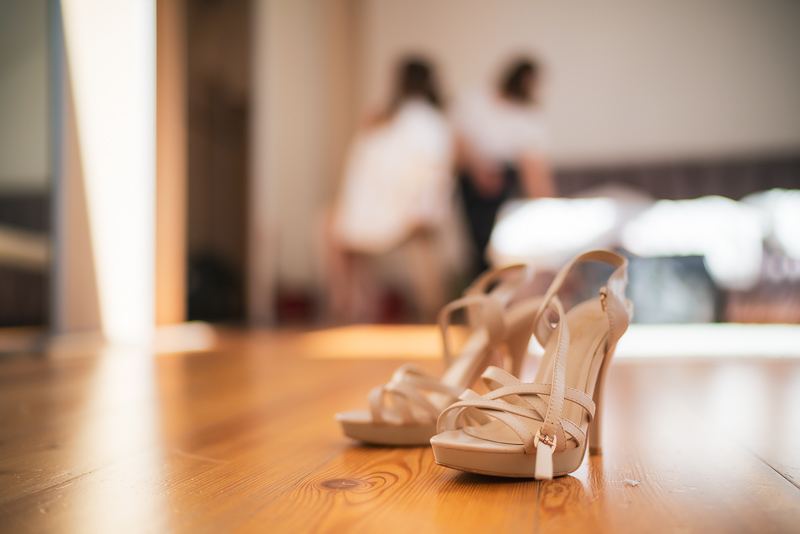
When focusing on something a bit further away it is still nice, but you can start to see double edged structures and a bit of busyness in the corners:
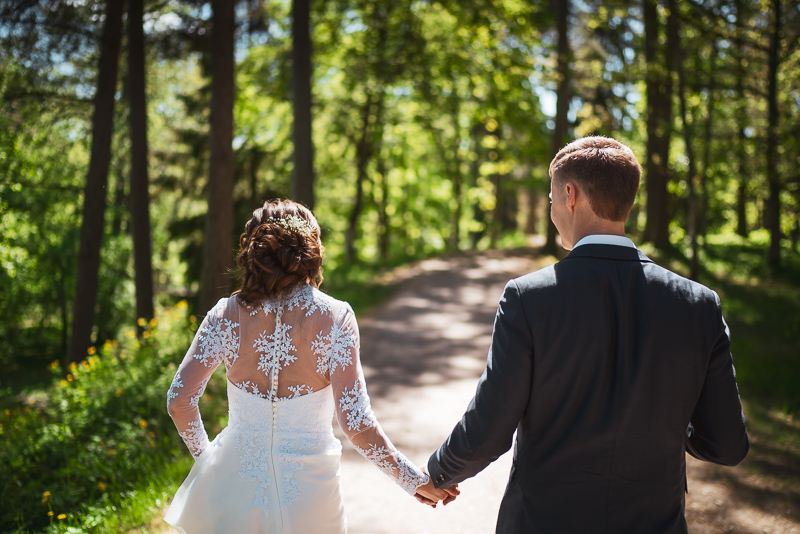
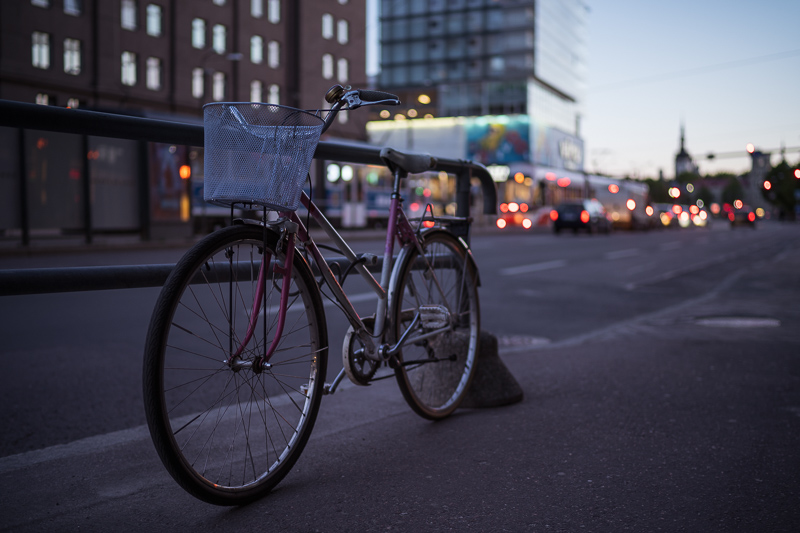
At longer distances (e.g. full body portraits) where the transition zone overlaps with the background many fast wide angle lenses struggle. This is also somewhat true for the Sony FE 35mm 1.4 ZA.
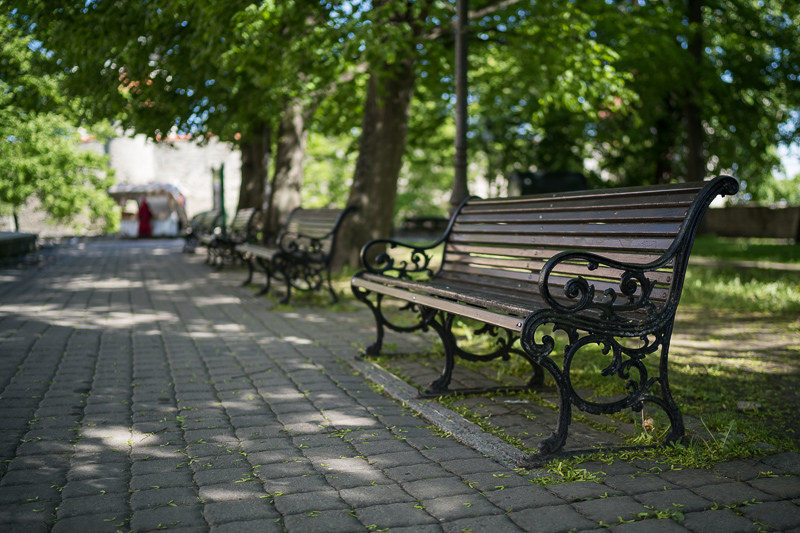
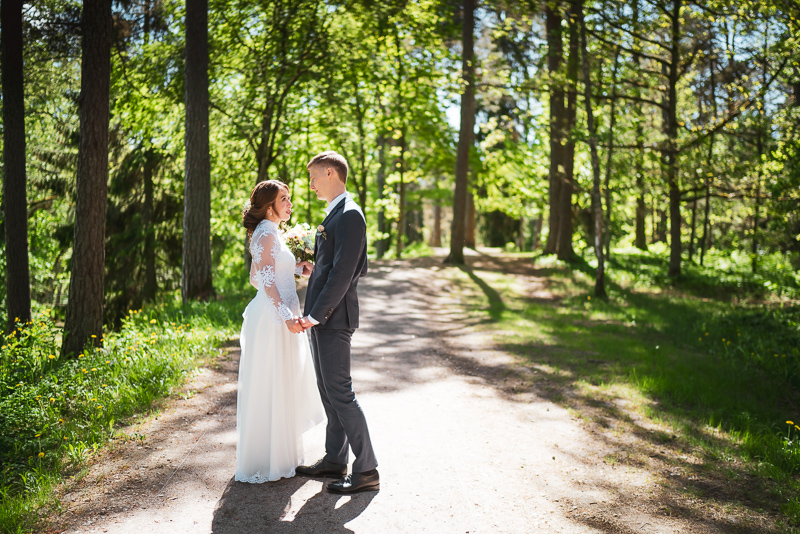
The Sony FE 35mm 1.4 ZA still uses less refined aspherical elements that lead to onion ring structures in light circles. Actually, this is pretty much the worst performance I have seen in an f/1.4 prime lens so far.
Whether this bothers you or not depends a lot on what subjects you are usually shooting: if you do lots of shooting in the city during blue hour it probably will, if you usually take pictures in more rural areas and forests it may not at all.
Best have a look at the sample images and see for yourself if you like the rendering or not.
Sunstars
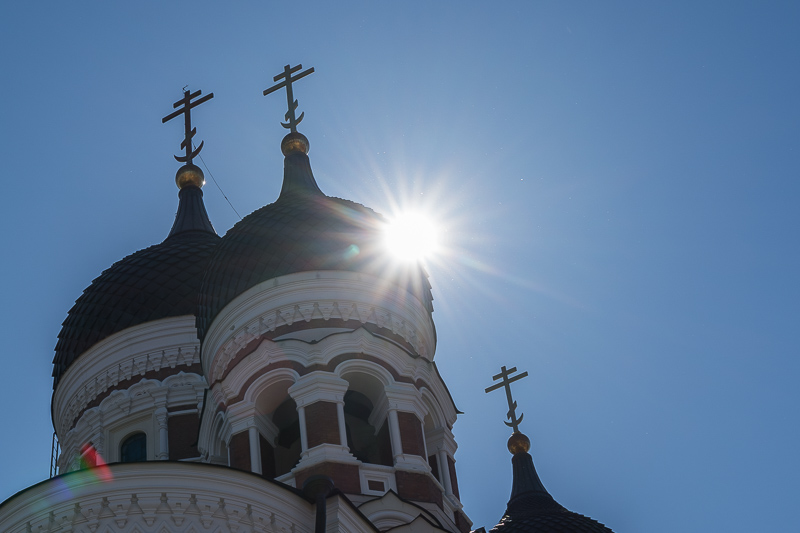
Many of the earlier Sony FE lenses feature not so well aligned aperture blades and this one is no exception. Therefore the sunstars are not really well defined with uneven spacing and length of rays.
If you want to know more about sunstar rendering of different lenses have a look at this article.
Chromatic aberration
lateral
100% crops, A7III
Even with all corrections in camera and in Lightroom deactivated there is still a profile for correcting lateral CA applied. So here I was using a freeware raw converter to show you how the lateral CA look without correction.
As these are losslessly corrected this is not a big deal.
longitudinal
50% crops, A7rII
Like most of the early FE lenses longitudinal CA are not corrected exactly well. Even stopped down to f/2.8 you will often manage to have visible green and magenta outlining in your pictures.
In very demanding scenes like the one below you can easily spot several pixel wide outlining. This is very hard to correct in post.
A7III, f/1.4
Focus shift
In the center of the frame there is no focus shift visible, but midframe and corners do strange things on stopping down, have a look at the sharpness section.
Alternatives
Autofocus
Sigma 35mm 1.2 Art:
The best 35mm lens at combining high sharpness and contrast with smooth bokeh. Unfortunately it is even bigger and heavier but similarly priced. If you are looking for the best 35mm lens right now this is it.
buy from amazon.com | B&H | ebay.com | ebay.de for about $1499/1529€ (affiliate links)
Sigma 35mm 1.4 Art:
The Sigma 35mm 1.4 Art offers an AF/MF switch, a much nicer focus ring with mechanical coupling and you can get it for about half the price.
Sample variation is less of an issue here so the average Sigma should outperform the average Sony resolutionwise, contrast may be slightly higher on the Sony though. Bokeh is slightly nicer on the Sony, but only in certain situations this will be visible.
buy from B&H | amazon.com | amazon.de for ~770$ (affiliate links)
Samyang 35mm 1.4 AF:
This Samyang looks quite a bit comparable to the Sony lens reviewed here: similar size, similarly high CA, similar questions regarding sample variation. You are loosing the aperture ring and according to some reports the manual focus experience is even worse with this lens.
From the (few) comparisons I saw the bokeh of the Sony lens looks slightly nicer.
This is your cheapest option when looking for a native 35mm f/1.4 lens with AF, personally I would pay slightly more to get the aforementioned Sigma lens.
buy from B&H | amazon.com | amazon.de for ~550$ (affiliate links)
Canon EF 35mm 1.4 L II USM:
Might have been “the best” 35mm 1.4 lens before the Sigma 35mm 1.2 Art and Tamron 35mm 1.4 came out.
buy from B&H | amazon.com | amazon.de for ~1649$ (affiliate links)
Sony RX1RII (Sonnar 35mm 2.0):
As we still have no decent AF 35mm f/1.8 or f/2.0 lens I have to list this camera. Rendering is quite similar, but you are obviously loosing one stop and the lens is also noticeably wider.
buy from B&H | amazon.com | ebay.com | ebay.de for 3299$ (new) or 1999$ (used) (affiliate links)
Manual focus
Zeiss ZM 35mm 1.4 T* Distagon:
This lens is noticeably smaller, offers similary high contrast but struggles a bit on Sony cameras due to the thicker filter stack.
buy from B&H | amazon.com | amazon.de | ebay.com | ebay.de for ~1999$ (affiliate links)
Voigtlander VM 35mm 1.7 Ultron:
This is still my 35mm lens of choice and there is a reason for that: it is one of the best balanced lenses money can buy. It really needs a 5m PCX filter to shine on Sony cameras, but going through that trouble is totally worth it.
buy from B&H | amazon.com | ebay.com | ebay.de for ~ 809$ (affiliate links)
7artisans 28mm 1.4 FE+:
If you prefer slightly wider this may be worth a look. The f/1.4 sharpness is slightly worse compared to the Sony lens reviewed here as is the contrast, but color correction is definetly better.
buy from B&H | amazon.com | amazon.de | ebay.com | ebay.de for ~$499 (affiliate links)
Voigtlander 40mm 1.2 Nokton E:
Less wide and slightly faster. The bokeh might be a little less smooth and this lens also suffers from onion ring patterns. Close up performance is worse (you can use a close up filter to make up for that). Personally I don’t like it for the abrupt sharpness drop off close to the corners, but many people greatly enjoy this lens.
buy from B&H | amazon.com | ebay.com | ebay.de for ~1099$ (affiliate links)
Conclusion
good
|
average
|
not good
|
It is quite hard to write a balanced conclusion on this lens. Not only does it fall short of the newer GM lenses, but even compared to significantly cheaper lenses it doesn’t fare to well:
The longitudinal CA are really not well corrected and at the same time not something you can easily fix in post. Same is true for the onion ring bokeh.
Distortion is also pretty high for a lens like this and if that isn’t enough there is the huge sample variation and the “interesting” behaviour on stopping down (combination of field curvature and focus shift off center). If you are looking for a lens with even sharpness for landscape and architecture shooting there are surely better options out there.
But do these things actually matter for the applications you want to use a lens like this for? Maybe not.
From the sample pictures you can see I was confident enough to use this lens for a wedding and it delivered the results I was looking for. The high contrast helps to make your subject stand out.
But this might have also been true for Sigma 35mm 1.4 Art or even the Samyang 35mm 1.4, costing half to third of the Sony FE 35mm 1.4 ZA.
This lens shows how far Sony has come since the introduction of the FE system. It also shows, there really is room and need for a 35mm lens on the GM level. If you like the 24mm 1.4, 85mm 1.4 or 135mm 1.8 – and that is why you want to buy this lens – you may be disappointed, so better consider the Sigma 35mm 1.2 Art, which comes way closer, to what you would expect from a GM lens.
You can usually find the Sony FE 35mm 1.4 ZA on amazon.com/amazon.de, B&H or ebay.com/ebay.de for about $1499/1499€ new or used for a few 100 bucks less (affiliate links)
Sample Images
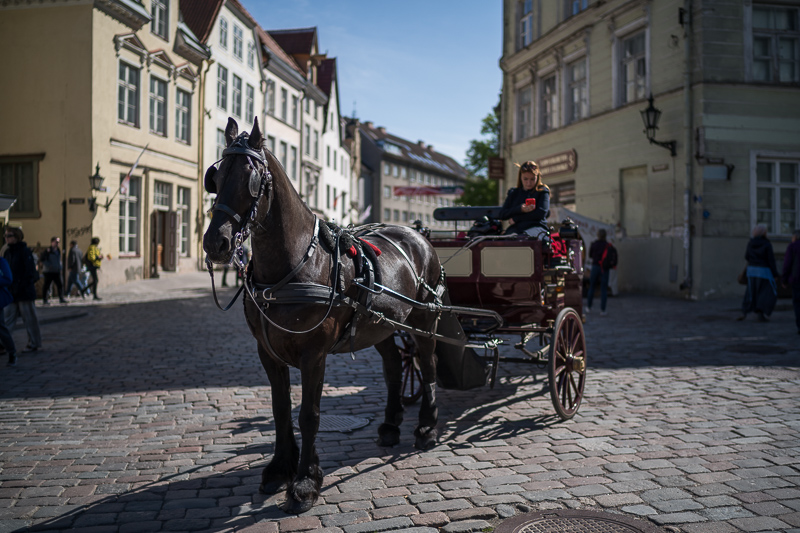
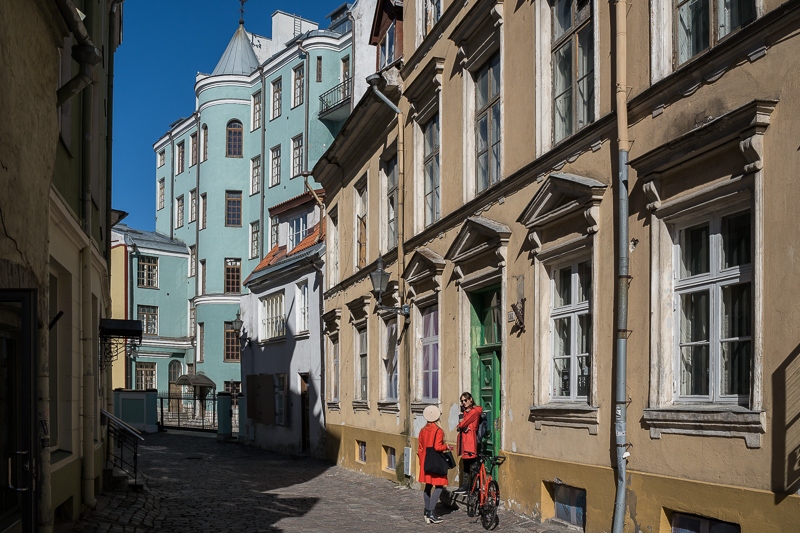
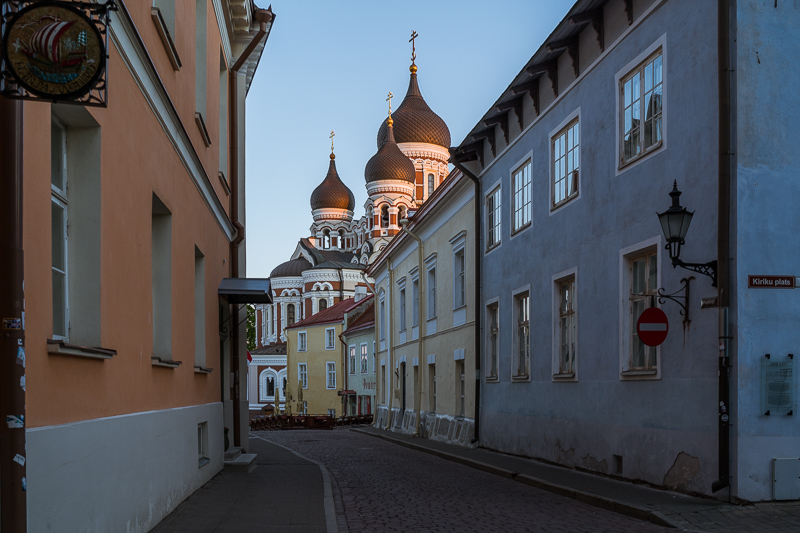
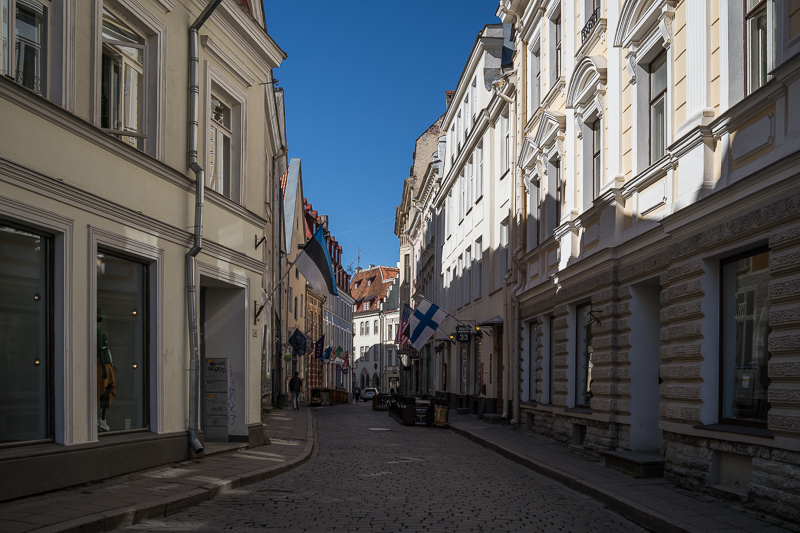

Most of the sample images in this review can be found in full resolution here.
Further Reading
- Sony FE lenses: Our comprehensive and independent guide
- Sony FE lenses: Our guide to portrait lenses from 85 to 135mm
- Review: Sony FE 85mm 1.4 GM
- Review: 7artisans 28mm 1.4 FE+
Support Us
Did you find this article useful or just liked reading it? Treat us to a coffee!
![]()
![]()
![]() via Paypal
via Paypal
This site contains affiliate links. If you make a purchase using any of the links marked as affiliate links, I may receive a small commission at no additional cost to you. This helps support the creation of future content.
Latest posts by BastianK (see all)
- Review: SLRmagic 50mm 0.95 Hyperprime LM - July 5, 2025
- Full Resolution Pictures getting fixed - July 4, 2025
- Analogue Adventures Part 42: A wedding with Eastman Double-X 200 - July 2, 2025






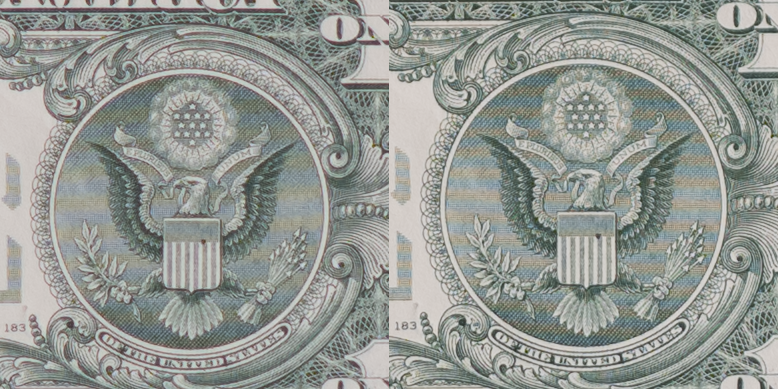




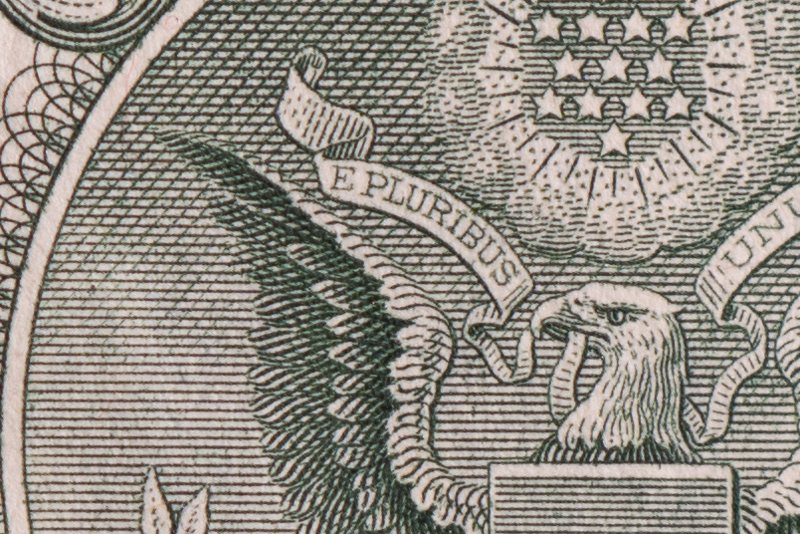

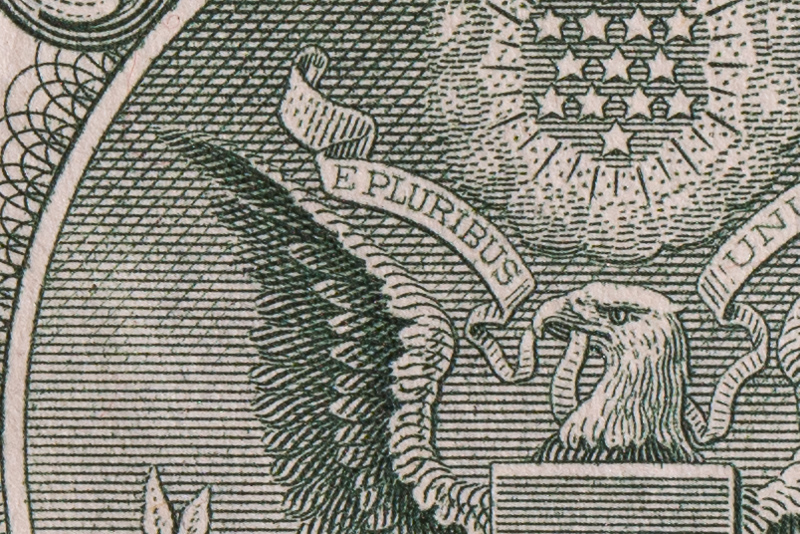
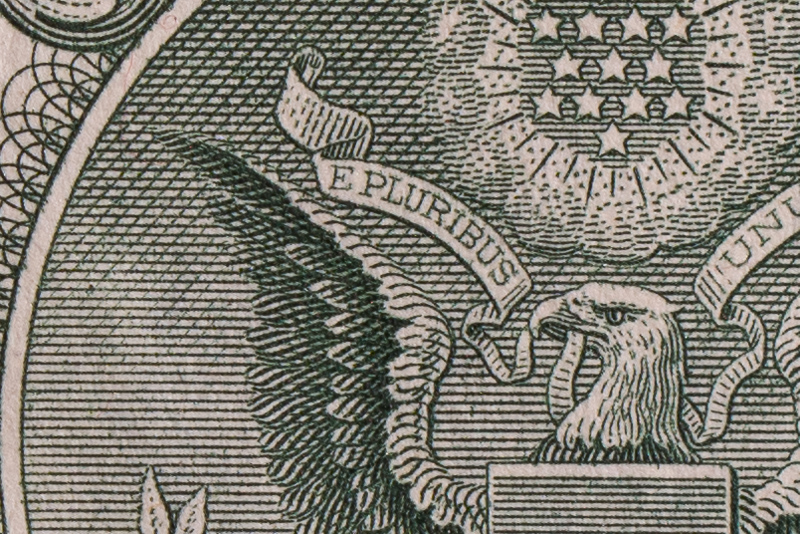
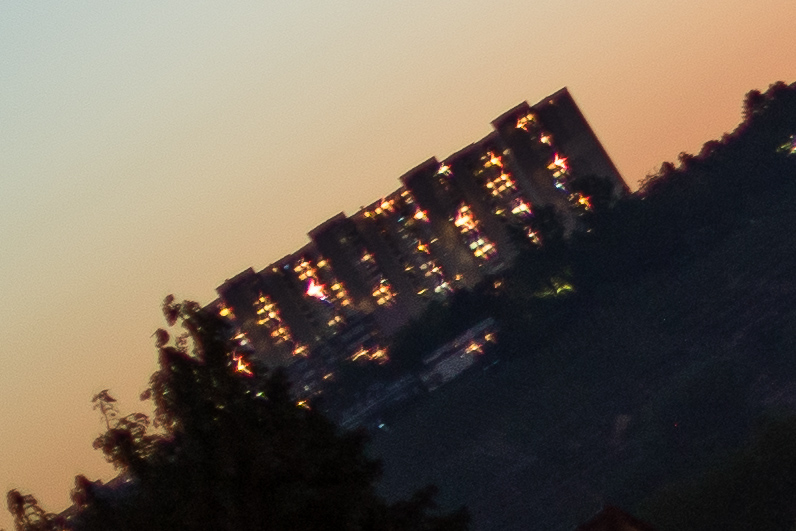
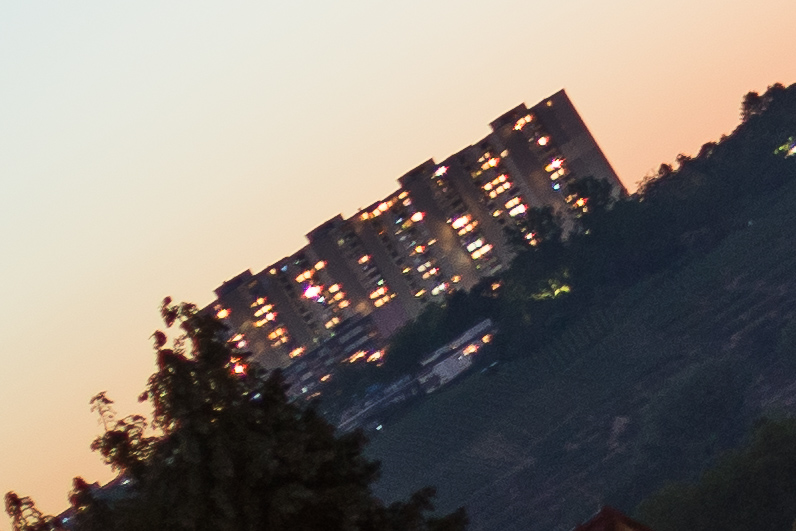
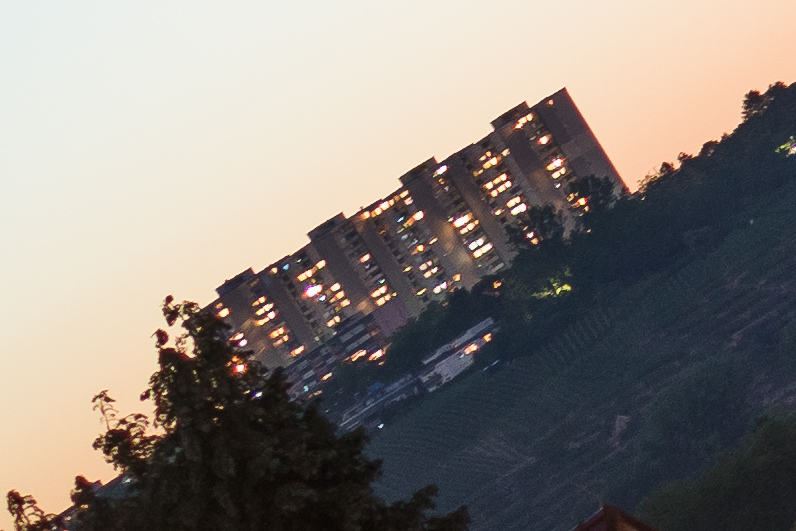
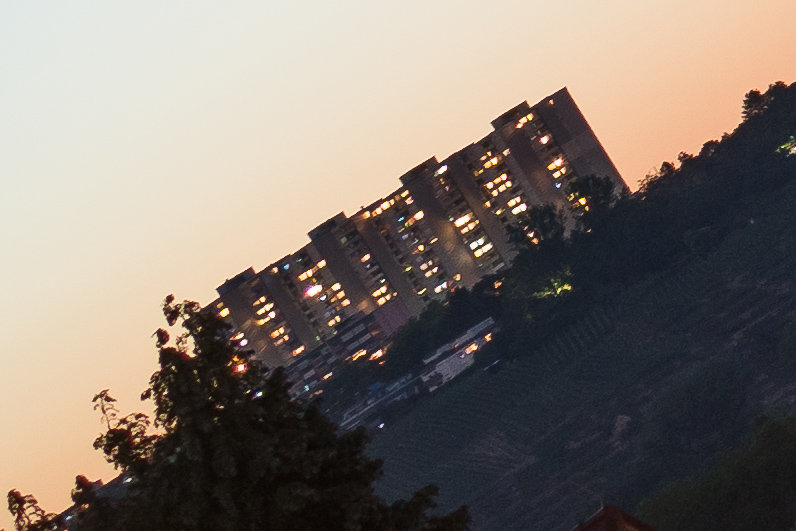
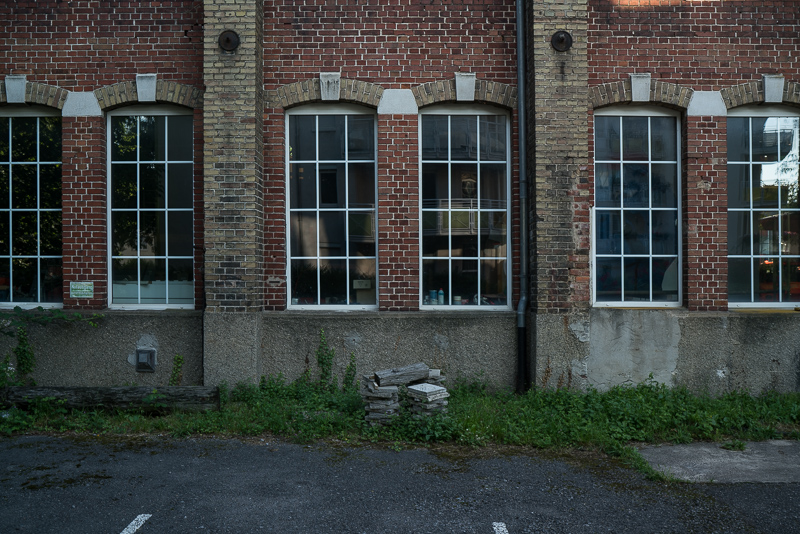
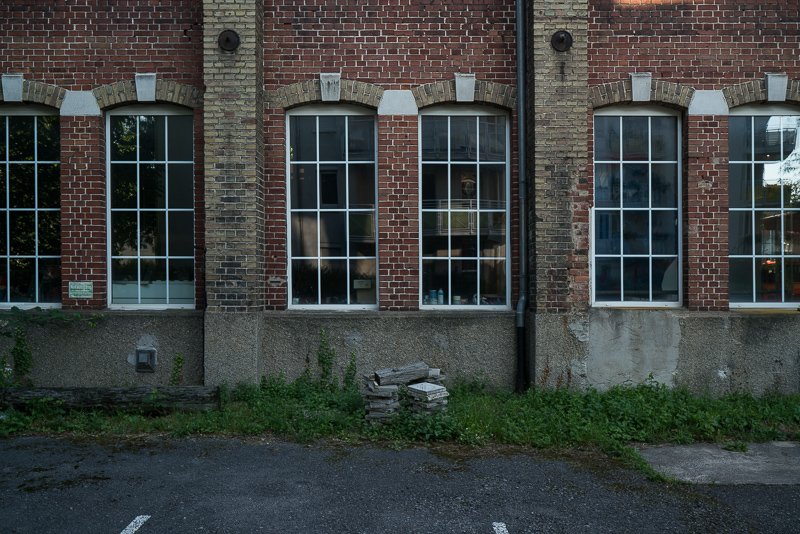
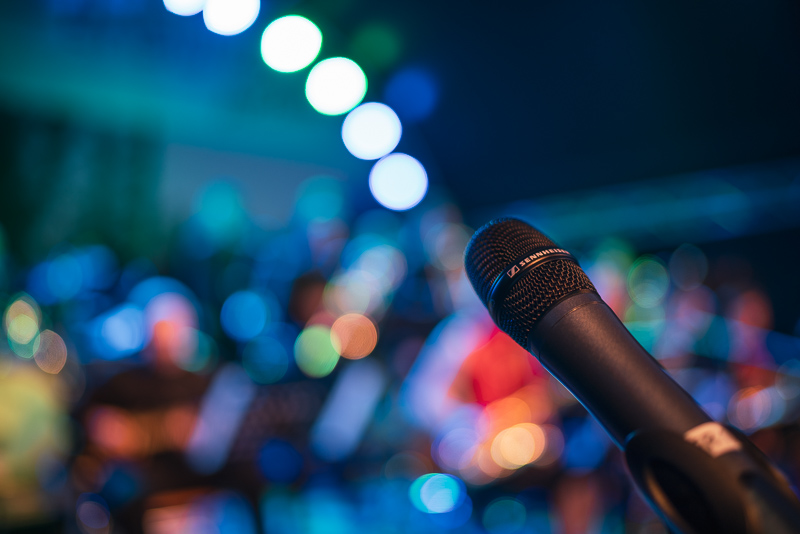

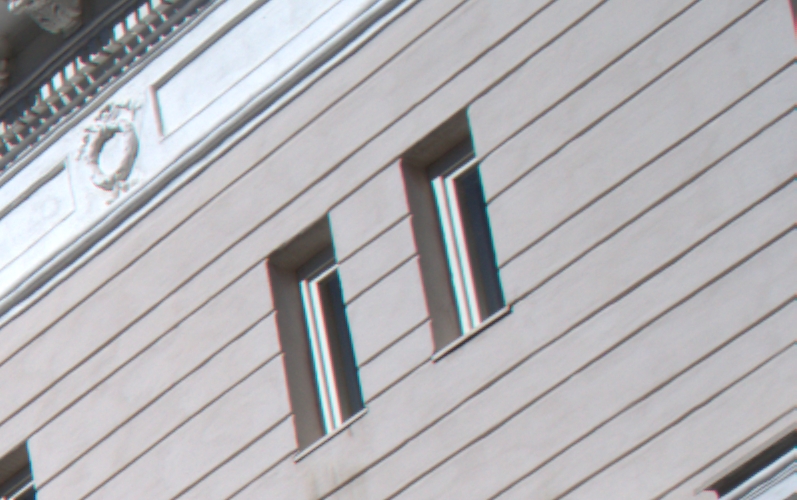

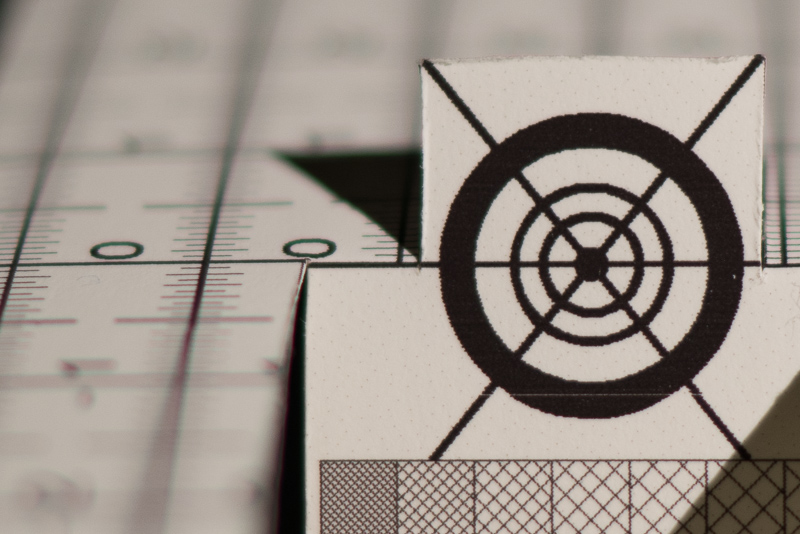
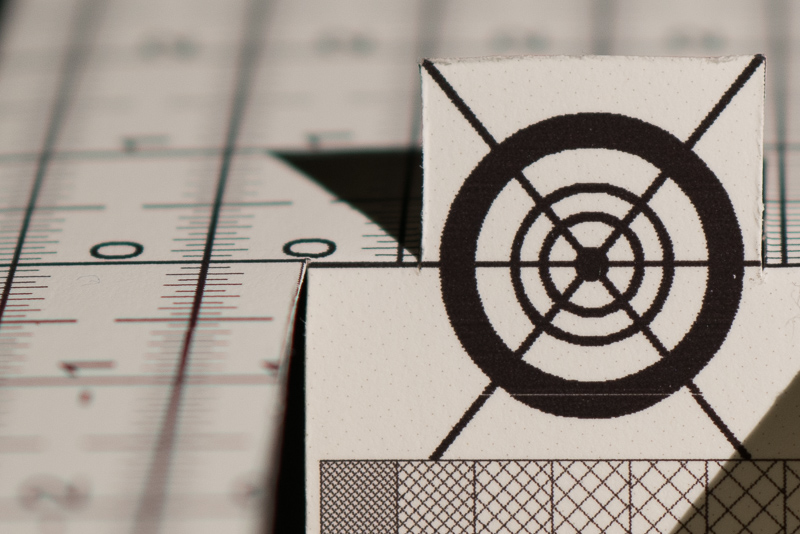
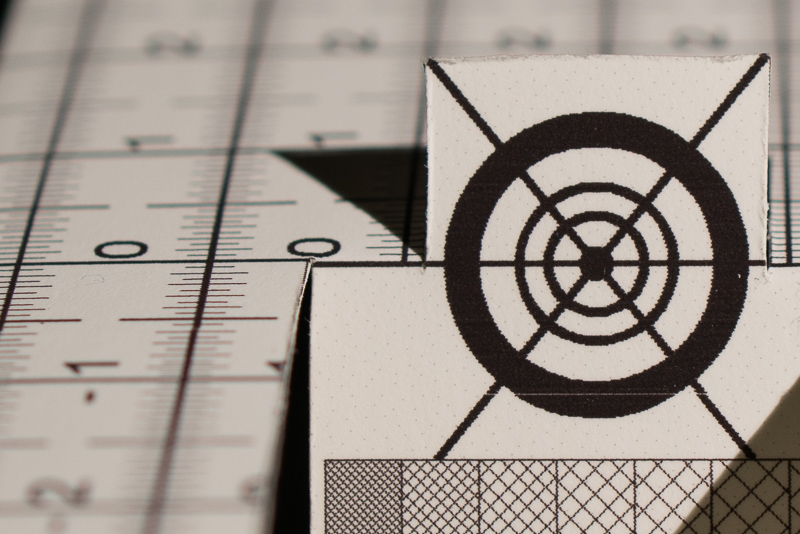
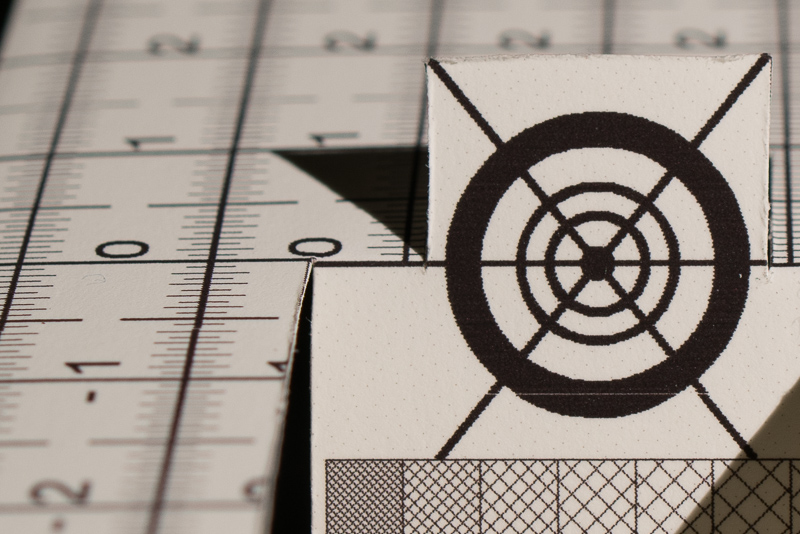
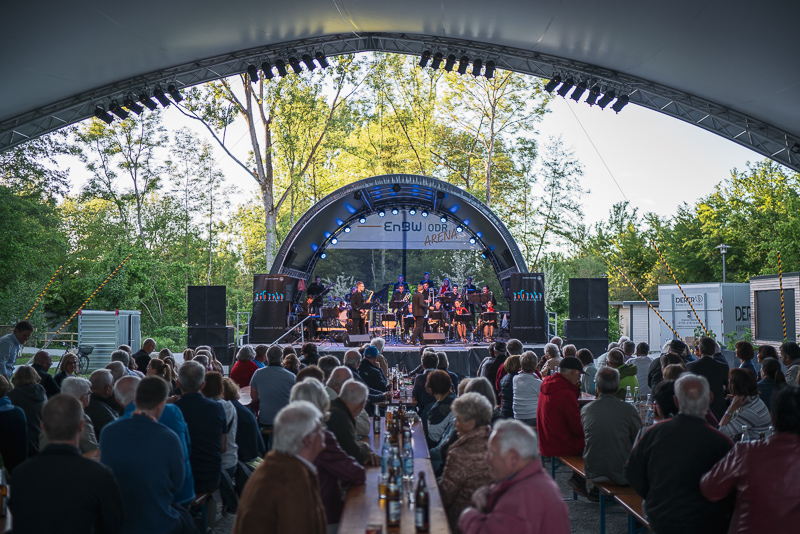
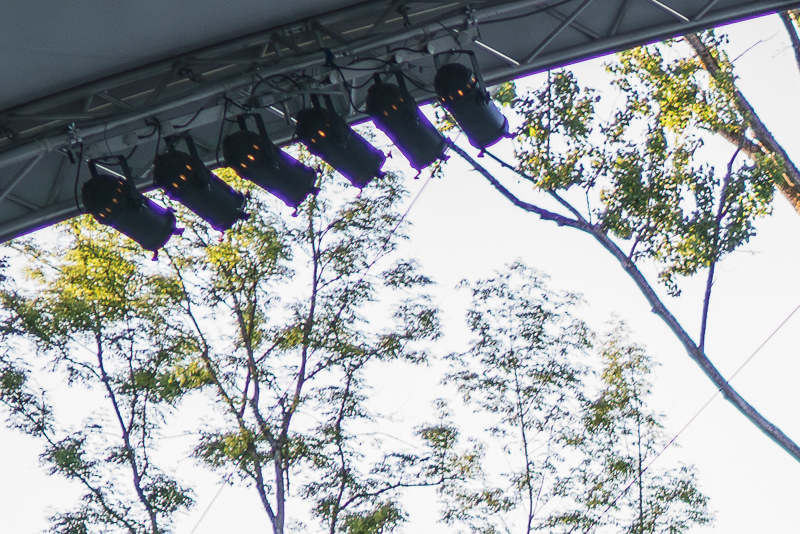
I always wonder, why Sony continues to press the obviously under-designed lenses (like this one or E16/2.8), never releasing the “II” version with necessary fixes and tweaks. Compare this to a long list of Canon EF-S 18-55 versions.
I guess they will do the version II of the lenses once the system starts to get complete.
Great review as always!
For me I went for the 40 batis. Slower but much lighter, incredibly sharp and well corrected plus great coma performance. The closeup feature is a bonus. Focus is quite, blazingly fast, and now firmware is fixed, accurate. The bokeh isn’t perfect compared the the 35 1.4 but it’s still good enough for my uses.
Nice review. It’s weird, I switched from the Canon 35/1.4L to this lens when I switched system in 2015. Never regretted it and never used a different copy. I love the rendering and separation. Maybe I have a good one? That said, it’s a mystery to me when Sony has not delivered a 35 GM.
Thing is, this lens is better in most respects (except onion rings if you care) than the Canon 35 mm f1.4L! Bastian didn’t compare it to that older lens. I’m guessing Mk 2 Canon, which came out after the ZA, is better. It’s easy to forget how long the ZA was around. It may we’ll have been the best 1,4/35 around when it was released, except for the Sigma.
Superb review!
Where should be sharpness in the conclusion? Good? Average?
Rather average
This is an a great review. I have owned this lens for 2.5 year and don’t have any complaints. I also don’t know any better.
really too bad sony does not have a lens like canon rf 35/1.8.
if that doesnt change in the next 2 years i might switch to canon once they established their MILCs a little more
Do you think they will manage to produce a competetive camera until then 😉
They certainly build excellent lenses but lack in the camera department.
How many years do you think Canon needs to produce a competitive camera?
I was surprised how uncompetetive their first cameras were but I think they could become competetive with the next generation.
Apparently the Sony 35mm f/1.8 is coming soon.
Good for me!
Let’s hope its a decent lense and <500EUR
Great review!
It is a pity that sample variation is so high that people shy away from it. My sample’s sharpness seems to be pretty much in line with dxomark’s test (which might be the best case scenario for this lens), so I find it to be a very good allrounder for landscape and people (if sunstars are not relevant).
The only thing I do not like is the weight, overall size, and the size of the front element, which can negatively affect reportage type photography of social situations, i.e. looking into this behemoth can be very intimidating. This is why I got the 35 2.8 ZA to complement this lens.
Build quality is OKish, being spoiled by the recent GM lenses (I own the 24 GM as well) does not help in this regard. So maybe the lens would have *scored* higher in your review if you’d had find a good copy before the release of the GM’s 😉
I am very happy with its performance and will continue to use it for environmental portraits of my kids, the 24 GM is too wide in most situations. I can live with its shortcomings (weight/size) for now, until Sony updates this focal length with either a 35 1.4 GM or (preferred) a 35mm 1.8 G. The bokeh of the Batis 40mm was a let-down for me, I consider bokeh quality a more important lens feature than sharpness, as it is much more obvious in the images on my A7III.
I have made some tests with my copy of the lens here for reference:
http://morsdorf.ch/gear/sony-35-mm-1-4-za/
Best, Felix
I think in many of the samples you had the electronic first curtain shutter activated,
that one can ruin the bokeh but also make the lens looks sharper as you are essentially shooting the top half of the frame stopped down.
Thanks for the tip.
I know about the former effect of EFCS and checked that effect in a small comparison (added that to the 35mm ZA blog post). It is clearly visible, but for me not that bad. Still, I had set my A7III so that I can quickly turn EFCS on or off, but generally I like to leave the EFCS on to reduce the shutter lag when capturing my kids.
I did not know about the latter, will test for its effect on my sharpness series soonish.
Many thanks!
im still trying to find an adapter that can achieve infinity focus with the SLB-50-5000PM filter. till then the sony 35mm 1.4 will be used more than the vm though the vm is not bad at f8 for landscapes and wide open for portraits
* So i found a cheap techart pro adapter and the ultron 35 1.7 can now rich infinity with the optosigma filter. It is now sharper than the FE35 1.4 at most of the frame and autofocus is acceptable. The colours are not as vibrant as with the sony zeiss.
after collecting most of the legacy fast 35mm lenses, I went with the sigma art 35mm 1.4 in sony e mount to gain AF to keep up with my kids and am quite happy with it. The sigma is on my camera more than 75% of the time.
When I was buying the lens b&h sent me the a-mount version in mistake so I tried it out before sending it back and with the LA-EA4 the af seemed better than the AF on the sigma e-mount version. I’ve definitely missed some shots as my kids are 2 and move quite quickly so I wouldn’t recommend when AF is required for fast moving objects.
Nice review.
However after Sony’s 24/1.4 this lens looks a bit frustrating.
PS Greetings from Tallinn:)
Hello. Thank you for the review!
Will there be a review of the 50mm 1.4 ZA lens?
Or maybe you have you used it – wondering if it suffers from the same weaknesses as this one?
There will be but don’t ask when 😉
The 1.4/50 ZA is a very different lens.
I wish, Sony/Zeiss would update 35 1.4 to the level of 50Z1.4.
It´s relly a nice example of what Sony has done right with their GM lineup and what they have done wrong with the Zeiss series.
There are some optically good lenses with high prices as the 55 1.8, the 16-35 and the 35 2.8, but there are also overpriced lenses with only average performance like the 24-70 and the 16-70.
On contrary, the GM lenses are expensive, but deliver in optical and mechanical quality. The Sony-Zeiss lenses are no match for GM, the Batis and Loxia lineup.
I think the Zeiss-Lineup relly is one of the reasons for the bad reputation of the Sony lens lineup in the early states, where people said, Sony had only few and overpriced lenses.
I believe that Sony really didn’t take MILC seriously while releasing early ZA lenses. To them it was like another Walkman, not an optical instrument.
Like if you damage any ZA lens, you either get it replaced by warranty, or buy a new one. There’s no way to replace e.g. a front element, the entire optical assembly gets replaced, which costs as much as lightly used lens.
But in more recent lenses Sony stepped away from this practice, taking the FE lineup more seriously, and actually most recent lenses are very nice for respective money.
Thanks for the great review as usual! I’m a bit suprised by the poor midzone – corner performance. I owned two copies of the 35 Sony Zeiss as well in the last three years and compared those also to the Sigma 35. While my copies of the ZA weren’t as sharp in the center compared to the sigma (but still a bit sharper than your sample I’d say), they clearly outperformed the Sigma in terms of corner sharpness. Both of my copies were centered really well and showed only a minor loss of sharpness towards the edges of the frame, while the sigma was super sharp in the center but showed a corner performance comparable to your copy here. Hmm.. I guess I should have kept my last sample of the 35 🙂
Performance is very dependent on the focus distance.
At say 1.0 – 1.5 m the Sigma also has a noticeable midzone dip (which is not as apparent as on the ZA though) while at infinity the Sigma is clearly better and shows less of a midzone dip
(this is also somewhat reflected by the lensrentals MTF charts measured at infinity where the Sigma is noticeably better everywhere in the frame as well).
But still this one sample of the Sigma I have here right now is clearly and noticeably better everywhere compared to the 2 ZAs I tried.
At 1.0 – 1.5 m distance the Voigtlander VM 35mm 1.7 is clearly better than both off center (no matter whether they are shot at f/1.4 or f/1.7).
So the question isn’t really whether the ZA 35 1.4 is worse than the Art 35 1.4 or vice versa (generally there are various reasons why I would not
recommend to buy the ZA, I hope I laid it out here, but it may be even more obvious in my upcoming Sigma Art review),
the real question is, why – despite the obvious size benefit – both clearly loose to the Voigtlander.
Or to be more specific: why every fast 35mm lens I tried so far is clearly loosing to the Voigtlander.
Hi David, I have a sample of the ZA which behaves like yours: not quite as sharp as the a decent copy of the Sigma centrally, better in midframe and corners at least at portrait distances. Rishi at DPR had one like that too. I find it a very useful lens. But I agree with Bastian that it’s hard to reccomend, because samples are all over the place. Good samples like ours are good – but not great (look at the Lensrentals variation chart, not the average, to get a sense of the best case scenario) there’s no great AF fast 35, unless the CanonII which I haven’t tried) and also rare, so unless you are obsessed or very lucky, you won’t even get a good one.
Hi David,
I know you liked this lens at one point (saw it on Fred Miranda’s site), but I understand that you own a Sigma 35 1.2 now. I like the rendering of the Sony, but no one seems to want to recommend it because of the copy variation. If I went through the trouble of trying to get a good copy of the Sony, would it be worth it? The Sigma is just too big to carry around.
Thanks, in advance, for your reply.
Good question. I had an unusually good copy of the FE; fairly symmetrical and quite sharp in the centre from wide open.
I got a good one first off – but no-one I know has been as lucky! And it’s very frustrating playing that game (it took me many copies of the 2.8/90 to get a good one – I’m glad Sony has upped their game in this regard.
But yeah, it has a nice rendering, sharp but slightly lower contrast wide open in a way that can be attractive. And while many complain about it, it’s a technically better 1.4/35 than most that came before it except the Sigma.
But I now think you should probably try the Simga 1.4; which is cheaper and much lighter than the Sigma 1.2. I was convinced that the Zony had nicer rendering than the Sigma based on overall samples I saw, but that can be misleading. Then a friend visited me for a week who had a copy of the Simga and I did some identical A-B tests. It seemed to me then that it was almost impossible to see a difference in how they rendered – and the Sigma was just a little sharper centrally than my (very good) copy of the Zony.
So I’d be inclined to think the 1.4 Sigma is a better bet – unless you depend on fast eye AF, where the Zony remained somewhat better. The Sigma was OK in this respect, though.
The better midzone to corner performance of my two copies related to performance at infinity (I can spot a conifer about 80m from my balcony). I was always a bit disappointed with wide open performance at portrait distances. Here the sigma really killed the sony copies.
I’m surprised the Zeiss Loxia 35mm f/2.0 or Batis 40mm f/2.0 were not listed as alternatives.
The Loxia is a good landscape lens stopped down a lot.
The Batis still has AF issues and I am not recommending lenses that decide for the owner when to stop down.
I see neither as an alternative to a 35mm 1.4.
This was a disappointing lens in many ways and I owned MANY copies of it. The Samyang while cheaper, is much better in sharpness across the frame wide open with slightly better CA control and less horrible onion rings. Sure in some areas the bokeh on the zeiss will look smoother but that is hardly impressive when you consider how quickly sharpness degrades away from the center.
Since you mentioned a 40mm as an alternative, the current beast is the Sigma 40mm art. Sure is big but it cannot be touched IQ wise.
As always: Thank you very much for your review which (unlike many tests out there in the WWW) is both precise and related to real-world photography!
I always wondered how this lens, given one finds a good copy, would compare to other 35mm lenses in terms of sharpness. Personally, I mostly do architecture and landscape photography, but rather seldom portraits and other kinds of photography which emphasize wide-open performance. For me, this expensive and big 35mm lens would have been only interesting if it delivered best quality *both* wide open and stopped down. Indeed, some early (but not very detailed) tests suggested that this would be the case. But your tests clearly shows that this is not true. So I can definitely save the money this lens would cost ;–).
Disappointing performance. Sony need replace this lens with 35 F1.4 GM
I’m kind of surprised by this review. I bought this lens 4 1/2 years ago and absolutely love it. It runs circles around the Canon 35L I had previously owned on a 5D, and in those days I had red tests that showed it ouperformed even Leicas Summilux 35 M, that’s three times as expensive. So, maybe I got a good copy….
I am not surprised it is better than the more than 20 years old Canon.
And with regards to Leica lenses: a super high price does not necessarily warrant super high image quality.
Do you think now that this lens can be had for under $600 it’s worth it? Or better to only look at the sigma or the 1.8?
I would still look at other options, there are so many now.
Thanks Bastian! I appreciate your reply on such an old article. I will take your advice. 🙂
Luckily I see the comments as they are written, so it doesn’t matter whether the article is new or old 🙂